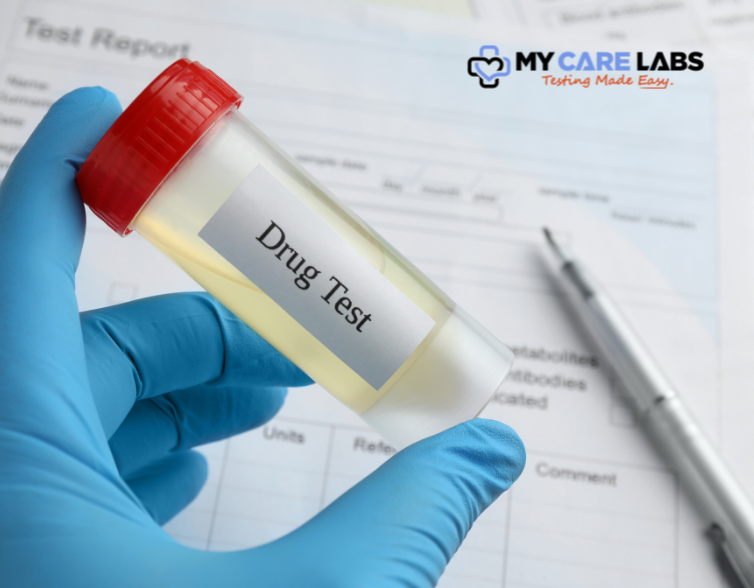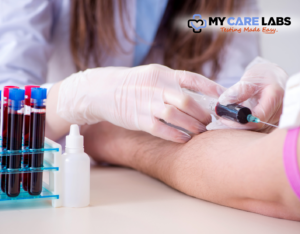Welcome to My Care Labs, a trusted provider of comprehensive screening solutions aimed at promoting health and well-being in our communities.
At My Care Labs, our mission is to ensure that individuals have access to reliable and accurate screening tests to address various health concerns.
In this guide, we introduce the Drug Abuse Screening Test (DAST), a vital tool in identifying and addressing substance abuse issues.
The DAST is designed to assess an individual’s involvement in drug abuse activities and to provide insights into the severity of the problem.
The purpose of this guide is to provide a comprehensive overview of the Drug Abuse Screening Test, its importance in promoting public health, and its role in fostering safe and healthy communities.
We will delve into the significance of drug abuse screening, the different types of tests available, and the implementation of screening programs.
Through this guide, we aim to raise awareness about the importance of drug abuse screening and to empower individuals and organizations to take proactive steps in addressing substance abuse issues.
Understanding Drug Abuse Screening Test (DAST):
Definition and Background of DAST:
- The Drug Abuse Screening Test (DAST) is a self-report instrument designed to assess the presence and severity of drug abuse or dependence.
- Developed in the 1980s by Harvey A. Skinner and Wendy N. Smith, the DAST has since become a widely used tool in clinical and research settings.
- It consists of 20 questions that inquire about various aspects of drug use, including frequency, consequences, and attempts to stop using drugs.
Importance of Drug Abuse Screening in Promoting Public Health:
- Drug abuse screening plays a crucial role in identifying individuals who may be struggling with substance abuse issues.
- Early detection through screening allows for timely intervention and treatment, which can prevent the progression of substance abuse disorders and associated health complications.
- By identifying substance abuse patterns and trends within communities, drug abuse screening helps public health authorities develop targeted prevention and intervention strategies.
Legal Implications and Regulatory Considerations:
- In many jurisdictions, drug abuse screening may be mandated for certain populations, such as individuals involved in the criminal justice system or safety-sensitive occupations.
- Employers may implement drug testing programs to ensure workplace safety and compliance with legal requirements.
- Regulatory frameworks govern the administration, accuracy, and confidentiality of drug abuse screening tests to protect individuals’ rights and privacy.
Role of Drug Abuse Screening in Ensuring Safe and Healthy Communities:
- Drug abuse screening contributes to the creation of safe and healthy communities by identifying and addressing substance abuse issues at the individual and population levels.
- Screening helps reduce the prevalence of drug-related accidents, injuries, and fatalities by identifying individuals who may be impaired due to drug use.
- It facilitates access to treatment and support services for individuals struggling with substance abuse, thereby promoting recovery and reducing the societal burden of drug abuse.
Prescription Drug Abuse Signs
Prescription drug abuse is a growing concern, with individuals often misusing or abusing medications prescribed for legitimate medical reasons. Recognizing the signs of prescription drug abuse is crucial for early intervention and support. Here are some key signs to be aware of:
Changes in Behavior:
- Mood Swings: Sudden mood changes, such as irritability, agitation, or euphoria, can indicate prescription drug abuse.
- Social Withdrawal: Withdrawal from social activities, hobbies, or relationships may be a sign of substance abuse.
Physical Symptoms:
- Changes in Appearance: Physical changes like weight loss, bloodshot eyes, or poor hygiene can be indicative of prescription drug abuse.
- Slurred Speech: Difficulty speaking clearly or slurred speech may be a sign of substance intoxication.
Psychological Signs:
- Memory Problems: Difficulty remembering things or lapses in memory can occur with prescription drug abuse.
- Confusion: Disorientation, confusion, or trouble concentrating may be observed in individuals abusing prescription medications.
Changes in Habits:
- Changes in Sleep Patterns: Insomnia or excessive drowsiness can result from prescription drug abuse.
- Financial Issues: Sudden financial problems or borrowing money frequently may indicate drug misuse.
Obsessive Behavior:
- Preoccupation with Medication: Constantly thinking or talking about medication, or obsessively seeking prescriptions, can be a sign of abuse.
- Doctor Shopping: Visiting multiple doctors to obtain multiple prescriptions is a common behavior among individuals misusing prescription drugs.
Risky Behavior:
- Engaging in Risky Activities: Prescription drug abuse may lead individuals to engage in risky behaviors such as driving under the influence or sharing medications with others.
- Legal Problems: Involvement in legal issues related to prescription drug possession or distribution is a significant red flag.
Recognizing these prescription drug abuse signs is crucial for early intervention and support. If you or someone you know is exhibiting these signs, seeking professional help and support is essential for recovery and well-being.
Benefits of Drug Abuse Screening Test:
Early Detection and Intervention for Substance Abuse Disorders:
- One of the primary benefits of the Drug Abuse Screening Test (DAST) is its ability to detect signs of substance abuse early on.
- Early detection allows individuals to receive timely intervention and treatment before their substance abuse issues escalate into more severe disorders.
- By identifying substance abuse patterns and risk factors, the DAST enables healthcare providers to intervene with appropriate counseling, therapy, or medication-assisted treatment.
Prevention of Drug-Related Accidents and Injuries:
- Screening individuals for drug abuse can help prevent drug-related accidents and injuries, particularly in safety-sensitive environments such as workplaces and schools.
- Identifying individuals who may be impaired due to drug use can prompt interventions such as counseling, treatment, or temporary suspension from safety-sensitive activities to prevent accidents and injuries.
Promotion of Treatment and Recovery for Individuals Struggling with Addiction:
- The DAST serves as a gateway to treatment and recovery for individuals struggling with addiction.
- By providing an objective assessment of drug use patterns and severity, the DAST helps individuals recognize the need for treatment and seek appropriate support services.
- Access to treatment and recovery resources can lead to positive outcomes such as reduced substance use, improved mental and physical health, and enhanced overall quality of life.
Reduction of Societal Costs Associated with Drug Abuse:
- Drug abuse imposes significant economic burdens on society due to healthcare costs, criminal justice expenses, lost productivity, and other indirect costs.
- By facilitating early intervention and treatment, the DAST helps reduce the societal costs associated with drug abuse.
- Treatment and recovery services can lead to long-term reductions in healthcare utilization, criminal behavior, and social welfare expenditures, resulting in cost savings for communities and governments.
The Drug Abuse Screening Test offers numerous benefits in terms of early detection, prevention, treatment, and cost reduction, making it a valuable tool in promoting public health and safety.
Types of Drug Abuse Screening Tests:
Urine Drug Tests:
- Urine drug tests are among the most common methods used for screening individuals for drug abuse.
- These tests detect the presence of various drugs or their metabolites in urine samples collected from individuals.
- Urine drug tests are relatively non-invasive and can detect recent drug use within a few days to a week, depending on the substance.
Saliva Drug Tests:
- Saliva drug tests, also known as oral fluid tests, analyze saliva samples to detect the presence of drugs or their metabolites.
- These tests are convenient and easy to administer, requiring individuals to provide a saliva sample by swabbing the inside of their mouth.
- Saliva drug tests are particularly useful for detecting recent drug use, as drugs typically remain detectable in saliva for a shorter duration compared to urine.
Hair Follicle Drug Tests:
- Hair follicle drug tests involve analyzing hair samples to detect the presence of drugs or their metabolites.
- These tests can detect drug use over a longer period, as drugs become incorporated into the hair shaft as it grows.
- Hair follicle drug tests are often used to detect chronic or habitual drug use, as they can provide a history of drug use over several months.
Blood Tests:
- Blood tests are another method used to screen individuals for drug abuse, although they are less commonly employed due to their invasive nature.
- These tests involve collecting a blood sample from individuals and analyzing it for the presence of drugs or their metabolites.
- Blood tests are highly accurate and can detect recent drug use, but they are typically reserved for specific situations such as medical emergencies or legal proceedings.
Breathalyzer Tests for Alcohol:
- Breathalyzer tests are specifically designed to detect alcohol consumption by measuring the concentration of alcohol in an individual’s breath.
- These tests are commonly used to screen individuals for alcohol impairment, particularly in situations such as roadside sobriety checks or workplace safety assessments.
- Breathalyzer tests provide immediate results and are non-invasive, making them a convenient tool for alcohol screening.
Each type of drug abuse screening test has its advantages and limitations, and the choice of test depends on factors such as the specific drugs being screened for, the detection window required, and the preferences of the testing facility or organization.
Implementing Drug Abuse Screening Programs:
Developing Comprehensive Drug Abuse Screening Policies:
- Organizations must develop clear and comprehensive policies outlining the purpose, procedures, and consequences of drug abuse screening.
- These policies should detail the types of drugs being screened for, the frequency of testing, and the repercussions for positive test results.
- It’s essential to ensure that these policies comply with relevant laws and regulations governing drug testing in the workplace.
Educating Individuals about the Importance of Drug Abuse Screening:
- Organizations should provide education and awareness programs to inform individuals about the importance of drug abuse screening.
- These programs should emphasize the potential risks and consequences of drug abuse, as well as the benefits of early detection and intervention.
- Educating individuals about the purpose and procedures of drug testing can help alleviate concerns and promote compliance with screening protocols.
Establishing Protocols for Administering Drug Tests:
- Clear protocols should be established for administering drug tests, including procedures for sample collection, handling, and analysis.
- It’s crucial to ensure that all testing procedures adhere to industry standards and best practices to maintain the accuracy and reliability of test results.
- Organizations may choose to conduct drug tests on-site or utilize third-party testing facilities, depending on their resources and capabilities.
Training Staff to Conduct Drug Tests Effectively:
- Staff members responsible for administering drug tests should receive comprehensive training on proper testing procedures and protocols.
- Training should cover topics such as sample collection techniques, chain of custody procedures, and equipment operation.
- Regular training and refresher courses can help ensure that staff members remain proficient in conducting drug tests accurately and efficiently.
Ensuring Confidentiality and Privacy Protection:
- Organizations must prioritize confidentiality and privacy protection throughout the drug testing process.
- Confidentiality measures should be implemented to safeguard individuals’ personal and medical information, including test results and related documentation.
- Strict protocols should be in place to restrict access to test results and ensure that information is only shared with authorized individuals on a need-to-know basis.
By implementing these strategies, organizations can effectively establish and maintain drug abuse screening programs that promote a safe and healthy work environment while respecting individuals’ privacy and rights.
Challenges and Considerations:
Addressing Stigma and Discrimination Associated with Drug Testing:
- One challenge organizations face is addressing the stigma and discrimination associated with drug testing.
- Individuals may feel stigmatized or unfairly judged if they are subjected to drug testing, leading to resistance or opposition to screening programs.
- Organizations must implement education and awareness initiatives to reduce stigma and promote understanding of the rationale behind drug testing.
Managing Costs and Budgetary Constraints:
- Implementing and maintaining drug abuse screening programs can incur significant costs, including expenses related to testing kits, laboratory services, and staff training.
- Organizations must carefully manage their budgets and allocate resources effectively to ensure that drug testing programs remain sustainable in the long term.
- Exploring cost-effective testing options and negotiating favorable pricing agreements with testing providers can help mitigate financial burdens.
Balancing Individual Rights with Public Safety Concerns:
- Drug testing programs must strike a delicate balance between respecting individual rights and addressing public safety concerns.
- While employers have a responsibility to maintain a safe work environment, they must also respect employees’ rights to privacy and autonomy.
- Organizations should ensure that drug testing policies and procedures are fair, transparent, and legally compliant, taking into account applicable privacy laws and regulations.
Ensuring Accuracy and Reliability of Drug Test Results:
- Ensuring the accuracy and reliability of drug test results is paramount to the effectiveness of screening programs.
- Factors such as sample collection, handling, and analysis methods can impact the accuracy of test results.
- Organizations must select reputable testing providers and laboratories that adhere to industry standards and best practices to minimize the risk of false positives or negatives.
- Regular quality assurance and quality control measures should be implemented to monitor the performance of testing procedures and maintain the integrity of test results.
By addressing these challenges and considerations proactively, organizations can enhance the effectiveness and credibility of their drug abuse screening programs while safeguarding individual rights and promoting a safe and healthy workplace environment.
Best Practices for Drug Abuse Screening:
Using Validated and Standardized Screening Tools:
- Employing validated and standardized screening tools ensures the reliability and accuracy of drug abuse screening results.
- These tools, such as the Drug Abuse Screening Test (DAST) or the Substance Abuse Subtle Screening Inventory (SASSI), have been rigorously tested and validated for their effectiveness in identifying substance abuse disorders.
- By using recognized screening instruments, organizations can confidently assess individuals’ drug abuse risk and provide appropriate interventions as needed.
Collaborating with Healthcare Professionals and Community Organizations:
- Collaborating with healthcare professionals, such as physicians, psychologists, and addiction specialists, enhances the comprehensive approach to drug abuse screening and intervention.
- Healthcare professionals can offer valuable insights and expertise in interpreting screening results and providing appropriate referrals for treatment and support services.
- Additionally, partnering with community organizations and support groups expands the network of resources available to individuals seeking assistance for substance abuse issues, promoting holistic and integrated care.
Providing Support and Resources for Individuals Testing Positive for Drug Abuse:
- It is essential to offer support and resources for individuals who test positive for drug abuse during screening.
- This may include providing access to counseling services, addiction treatment programs, peer support groups, and other relevant resources to facilitate recovery and rehabilitation.
- Offering a compassionate and non-judgmental approach to individuals struggling with substance abuse encourages them to seek help and actively engage in their recovery journey.
Regularly Reviewing and Updating Drug Abuse Screening Policies and Procedures:
- Drug abuse screening policies and procedures should be regularly reviewed and updated to ensure they remain current and aligned with best practices and regulatory requirements.
- As new screening technologies and methodologies emerge, organizations should evaluate their effectiveness and consider integrating them into existing protocols.
- Additionally, periodic training and education sessions for staff members involved in administering drug tests help reinforce proper procedures and maintain consistency in screening practices.
By adhering to these best practices, organizations can enhance the effectiveness of their drug abuse screening programs, promote early intervention and treatment, and ultimately contribute to the well-being and safety of individuals and communities.
Drug Abuse Through Toxicology Testing
Drug abuse through toxicology testing involves the identification of illicit substances or their metabolites in biological samples to assess drug use and potential abuse. Here’s a breakdown of drug abuse through toxicology testing:
- Definition: Drug abuse through toxicology testing refers to the analysis of biological samples, such as urine, blood, saliva, or hair, to detect the presence of drugs or their metabolites.
- Purpose: The primary purpose of drug abuse toxicology testing is to screen individuals for illicit drug use, monitor compliance with prescribed medications, and identify substance abuse patterns.
- Detection Methods: Toxicology testing utilizes various analytical techniques, including immunoassay-based methods, chromatography (e.g., GC-MS, LC-MS), and mass spectrometry, to detect drugs and their metabolites in biological samples.
- Common Drugs Detected: Toxicology testing can detect a wide range of drugs, including opioids, cocaine, amphetamines, benzodiazepines, cannabinoids, and synthetic drugs like fentanyl.
- Testing Settings: Drug abuse toxicology testing is conducted in diverse settings, including clinical laboratories, workplace drug testing programs, law enforcement agencies, addiction treatment centers, and forensic investigations.
- Detection Windows: The detection window for drugs varies depending on factors such as drug half-life, frequency of use, and the type of biological sample tested. Urine tests typically have a shorter detection window compared to hair or blood tests.
- Legal Implications: Results from toxicology testing may have legal implications, such as in criminal investigations, child custody cases, probation monitoring, and workplace disciplinary actions.
- Clinical Applications: Toxicology testing plays a crucial role in clinical practice for assessing substance abuse disorders, guiding treatment decisions, and monitoring patients undergoing addiction treatment.
- Prevention and Intervention: By detecting drug abuse early, toxicology testing facilitates timely intervention, treatment, and prevention strategies to address substance abuse issues and promote overall health and well-being.
- Confidentiality and Privacy: Ensuring confidentiality and privacy is essential in drug abuse toxicology testing to protect individuals’ rights and maintain trust in the testing process and healthcare system.






